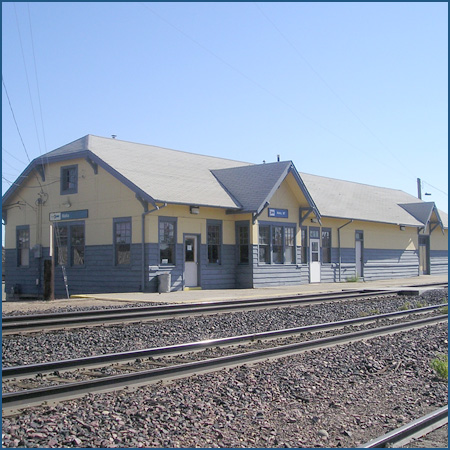Malta, MT (MAL)
Malta, named for a Mediterranean island, is located east of the Fort Belknap reservation, homeland to the Gros Ventre (Aaniiih) and the Assiniboine (Nakoda) tribes.

51 South 1st Street East
Malta, MT 59538-1732
Annual Station Ridership (FY 2024): 5,127
- Facility Ownership: BNSF Railway
- Parking Lot Ownership: BNSF Railway
- Platform Ownership: BNSF Railway
- Track Ownership: BNSF Railway
Alex Khalfin
Regional Contact
governmentaffairssea@amtrak.com
For information about Amtrak fares and schedules, please visit Amtrak.com or call 1-800-USA-RAIL (1-800-872-7245).
Malta, named for a Mediterranean island, is located 20 miles east of the Fort Belknap reservation, which is homeland to the Gros Ventre (Aaniiih) and the Assiniboine (Nakoda) tribes. The area around Malta is said to have inspired the work of famous western artist Charles Russell.
The depot, built by the Great Northern Railway (GN) in the early 20th century, resembles a Swiss chalet. For early regional boosters, this romantic architecture seemed appropriate to the Rocky Mountains, sometimes referred to as the “American Alps”; the style would influence the design of lodges and other buildings in the region’s national parks. The depot features horizontal wood siding on the lower half of the walls and the appearance of half-timbering on the upper portion. The roof, which has clipped gables, includes a large overhang supported by carved brackets that protects waiting passengers from inclement weather. Its design is quite similar to the old GN depots in Cut Bank and Libby. In addition to a waiting room, a portion of the building is also used by BNSF Railway crews that maintain the railroad.
The GN is considered to have been America’s premier northern trans-continental railroad, running from St. Paul, Minn. to Seattle. It was formed in 1889 by James J. Hill, who orchestrated the merger of the St. Paul and Pacific Railroad with the St. Paul, Minneapolis, and Manitoba Railway. Hill holds a special place in railroad history and lore, and is known as the “Empire Builder.” Whereas most transcontinental lines were built with federal assistance in the form of federal land grants, the GN did not utilize this method.
Hill’s business acumen guided the planning and construction of the GN. Much of the upper Midwest and West was sparsely settled, so instead of racing across the continent, the GN developed the regions through which it traveled as it steadily moved toward the Pacific. This action helped settle the land and created a customer base. Hill the businessman actively sought to establish trade links with Asia, and the railroad is credited with putting sleepy Seattle on the map and transforming it into an important and powerful Pacific Ocean port after the railroad reached the West Coast in 1893.
Station Building (with waiting room)
Features
- ATM not available
- No elevator
- No payphones
- No Quik-Trak kiosks
- Restrooms
- Unaccompanied child travel not allowed
- No vending machines
- No WiFi
- Arrive at least 30 minutes prior to departure
Baggage
- Amtrak Express shipping not available
- No checked baggage service
- No checked baggage storage
- Bike boxes not available
- No baggage carts
- Ski bags not available
- No bag storage
- Shipping boxes not available
- No baggage assistance
Parking
- Same-day parking is available; fees may apply
- Overnight parking is available; fees may apply
Accessibility
- No payphones
- Accessible platform
- No accessible restrooms
- No accessible ticket office
- Accessible waiting room
- No accessible water fountain
- Same-day, accessible parking is available; fees may apply
- Overnight, accessible parking is available; fees may apply
- No high platform
- No wheelchair
- No wheelchair lift
Hours
Station Waiting Room Hours
| Mon | 12:55 pm - 03:25 pm |
| Tue | 12:55 pm - 03:25 pm |
| Wed | 12:55 pm - 03:25 pm |
| Thu | 12:55 pm - 03:25 pm |
| Fri | 12:55 pm - 03:25 pm |
| Sat | 12:55 pm - 03:25 pm |
| Sun | 12:55 pm - 03:25 pm |


 Amtrak established the Great American Stations Project in 2006 to educate communities on the benefits of redeveloping train stations, offer tools to community leaders to preserve their stations, and provide the appropriate Amtrak resources.
Amtrak established the Great American Stations Project in 2006 to educate communities on the benefits of redeveloping train stations, offer tools to community leaders to preserve their stations, and provide the appropriate Amtrak resources. Amtrak is seizing a once-in-a-lifetime opportunity to transform rail and Retrain Travel. By modernizing, enhancing and expanding trains, stations and infrastructure, Amtrak is meeting the rising demand for train travel. Amtrak offers unforgettable experiences to more than 500 destinations across 46 states and parts of Canada. Learn more at
Amtrak is seizing a once-in-a-lifetime opportunity to transform rail and Retrain Travel. By modernizing, enhancing and expanding trains, stations and infrastructure, Amtrak is meeting the rising demand for train travel. Amtrak offers unforgettable experiences to more than 500 destinations across 46 states and parts of Canada. Learn more at